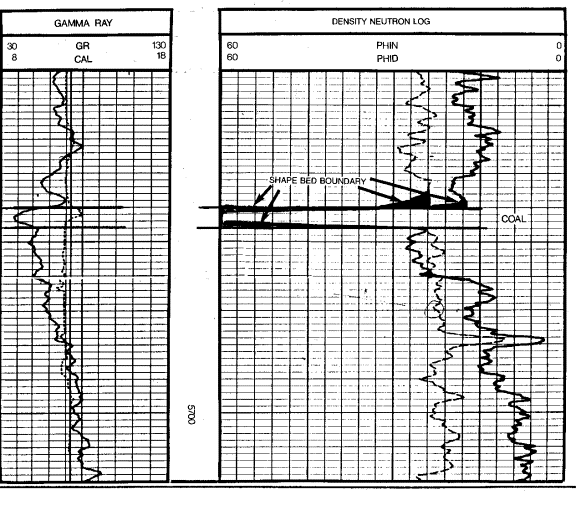|
 Shaping Logs for Quantitative Analysis
Shaping Logs for Quantitative Analysis
Calculators and computers will process data exactly as it is input.
Therefore, it is essential to edit or shape logs at abrupt bed
boundaries. Otherwise, unreasonable answers will result in the
boundary area. The example below illustrates a typical
coal bed with rounded corners at the bed boundary.
All
hydrocarbon zones show a similar bed boundary effect on the
resistivity log, resulting in strange water saturation values near
the bed boundaries. Software is now available to perform resistivity
inverse modeling that can sharpen the bed boundaries. Modern array
induction logs and laterologs have smaller bed boundary anomalies
than older logs.

Shaping log curves at bed boundaries
An
obvious lag is seen in the density and neutron data at the top
of the coal zone. The shaded areas indicate how the log should be shaped,
so that the computer analysis program will not give false shows
of hydrocarbon at the top of the zone. Sonic and resistivity logs
demand similar edits.
If
necessary, trim the tops and bottoms of other bed boundaries,
including interfaces between clean sand and shale, and limestone
- dolomite - anhydrite - salt sequences. Depth adjustments should
be made concurrently.
Thin
beds may also require curve shaping. Illustrated below are two
thin beds on the shallow resistivity curve at the base of each
clean sand. The deep resistivity curves show only a subtle hint
of these beds and do not indicate their true value. Resistivity
modeling software or a sharp red pencil will fix this.

Thin Bed Recognition on Shallow Resistivity Log
The
analyst can ignore the problem in this example, since the zones
are thin and do not contribute or detract from the reservoir,
but you may need to do significant work or run specialized thin-bed
logs in other cases.
A
second approach is to apply thin bed corrections, available from
service company charts. This work is usually done by hand as it
is more difficult to write suitable computer programs. Such programs
scan up and down one curve searching for thin beds and apply reasonable
corrections to another curve.
A
third and more pragmatic approach is to shape the deep resistivity
curve to match the shallow curve. Depending on the anticipated
hydrocarbon content, the curve amplitude can be amended higher,
lower or equal to the shallow curve. Do not try to extend this
concept to match the resolution of micro resistivity logs. Some
service companies can provide this service on some newer logs.
|

